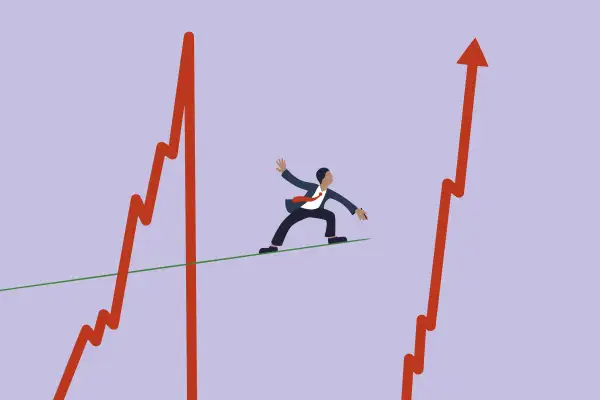How to Invest During a Stock Market Bubble
Money is not a client of any investment adviser featured on this page. The information provided on this page is for educational purposes only and is not intended as investment advice. Money does not offer advisory services.

The NBA and the NHL aren’t the only ones worrying about “COVID bubbles.”
Much of the tech sector, electric-vehicle stocks, and cryptocurrencies like Bitcoin now mimic the great market bubble of 2000, and some investors could soon see their portfolios go “pop,” according to several longtime market watchers.
The sense of déjà vu has struck one strategist, Christine Benz, director of personal finance for Morningstar, so hard that she feels compelled to “send up a flare” for investors who have never experienced a speculative frenzy before.
In 1999, when Dotcom stock prices were behaving like Tesla trucks strapped to space rockets, Benz was a mutual-fund analyst for Morningstar, the fund-data firm. She covered many of the mutual funds that rode the rocket before they imploded in 2000. Bubbles are notoriously hard to spot from the inside.
“This one feels much more familiar, much more akin to the late 90s period when I wished I had spoken up and more clearly articulated what was clearly a very frothy and very worrisome environment for smaller investors,” says Benz.
Parallels abound.
First, there are the exorbitant valuations — even more exorbitant in some areas than in 2000, says Lorenzo Di Mattia, manager of hedge fund Sibilla Global Fund, who is a student of the history of speculation. The Standard & Poor’s 500 price-to-earnings ratio, which quantifies how much investors pay for companies per dollar of profit, was recently at about 35 times the previous 12 months of earnings, one of the highest ever readings, according to Yardeni Research.
Two decades after investors rushed into Pets.com, unproven and unprofitable companies again sport multi-billion dollar price tags. Once again, everyone and their pet hamster wants in on initial-public offerings, no matter what the price or nature of the company. Indeed, the recent craze for Special Acquisition Companies, or SPACs, has seen investors buying newly launched enterprises before the people who launched them have even decided what the enterprise is going to do.
So how does an investor bubble-proof their portfolio? Here are some tips from Ms Benz and other strategists.
Focus on diversification, not performance
“Diversify your portfolio” has become a cliché in investing, but the logic becomes clear at times like the 2000 bubble, say Benz and others. Rebalancing your portfolio to spread it out over different investments tunes out “hindsight bias,” she says.
People who are buying into “FAANG” stocks or bitcoin right now are “assuming past performance leads to future returns,” says Benz. A period of outperformance only increases the risk of an investment going forward, she pointed out.
In the years following the 2000 bubble burst, money manager Brent Schutte “used to trot around a slideshow” showing that the stock market did not deserve its terrible reputation at the time. Most of the losses were inflicted on “certain segments” of the market that had “captured investors’ fancy,” says Schutte, chief investment strategist at asset manager Northwestern Mutual Wealth Management Co.
There’s only one truly “free lunch” in investing, according to Benz, and that’s diversification.
Ignore FOMO...and Bitcoin
The worst reason to buy a stock is because some anonymous poster on Reddit claims they just made $50,000 on it. “FOMO” — fear of missing out — is a real and powerful feeling in investing. Alas, if you’re smarting about missing out on a particular stock (or cryptocurrency’s) gain, then it’s almost certainly too late to do anything about it.
“When you have people with no credentials giving other people with no investment credentials advice about things they must do or should do — to me that’s a warning sign,” says Benz.
Bitcoin, the digital currency whose valuation is approaching that of the whole Dow Jones Industrial Average in the mid-1990s even as it awaits a raison d’etre, could be the “mother-of-all bubbles,” said Michael Hartnett Bank of America Global Research, in a note to clients. Sure, it could be the future of money, but what if it’s not?
It's all about timing
Most strategists agree that the electric-vehicle industry is going to be the center of a new economic era. But the same was true of the Dotcom companies. Many of them couldn't turn a profit while waiting for the Internet era to take shape.
In fact, according to economist Robert Shiller, citing a "new era" to justify frothy valuations is one of the most dangerous bubble signs of all.
It’s difficult for hedge-fund manager Mr. Di Mattia to keep a straight face when he describes the case of QuantumScape. Valued at about $20 billion, even after a selloff, QuantumScape aims to “revolutionize energy storage” (translation: make batteries for electric cars). Oh, and it might get around to generating significant revenue some time around 2026.
“Technically, it’s a business plan…it’s a great business plan, with smart people behind it, but it’s a business plan,” said Mr. Di Mattia.
For Ms. Benz, the obvious example is Tesla. The electric-car maker has turned a modest profit in recent quarters. But its price-to-earnings multiple is a Dotcomesque 1700 times.
More from MONEY:
The 21 Smartest Money Moves to Make in 2021
Why Emerging Market Stocks Are Poised for a Post-COVID 19 Comeback
Trading Stocks Has Never Been Easier. Here’s How Often Experts Say You Should Buy and Sell